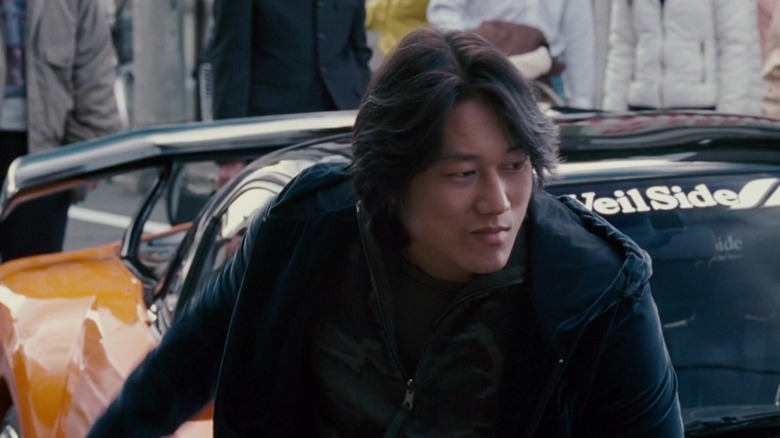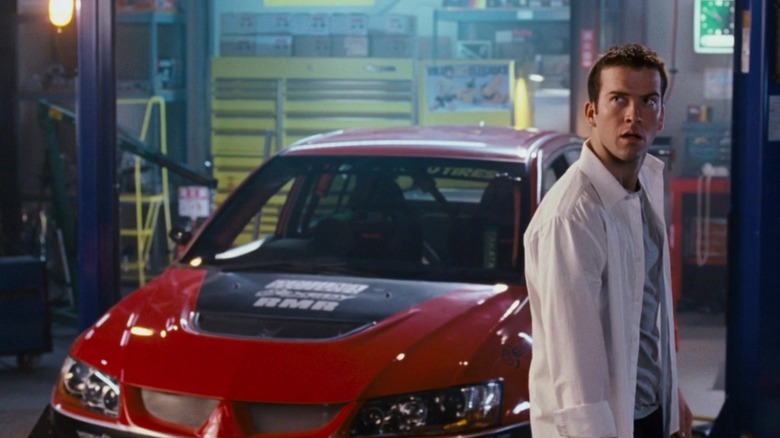The Fast And The Furious: Tokyo Drift Created A Job So Risky It Sounds Made Up
When Justin Lin's "The Fast and The Furious: Tokyo Drift" came out in 2006, it seemed like the series was pretty much over. The first two films in the series starred Vin Diesel and/or Paul Walker, charismatic leads that had developed great fraternal chemistry, leading both films to be giant hits (making $207 million and $236 million, respectively). It seemed, though, that neither actor was available to star in another outing, however, and the attention shifted to an all-new character named Sean, played by Lucas Black. The film also starred pop star Bow Wow and introduced Han (Sung Kang), a character carried over from Lin's 2003 drama "Better Luck Tomorrow." The action of the film was, as the title implies, transposed to Tokyo. It felt like a late-stage "last hurrah" style reboot.
Because Tokyo is such a densely packed city, the street races at the center of the "Fast and Furious" movies were more difficult to arrange. Many of the car races were staged in parking structures, forcing racers to master the art of the controlled skid, also known as drifting. Most of "Tokyo Drift" was filmed in Tokyo, including some of the racing scenes, so director Lin (born in Taiwan, raised in Buena Park, California) had to get to know the lay of the land pretty quickly.
Indeed, Lin came to learn that Tokyo is not an especially filmmaker-friendly city, as it doesn't issue filming permits. He also learned, as he revealed in a 2009 Digital Spy article, that some Japanese productions have a special "assistant" on hand, just in case the cops swing by to shut down any rogue productions shooting on the streets. Unbeknownst to him, Justin Lin had a legitimate "director's decoy" on set, just in case the cops needed to arrest someone.
Someone was arrested while posing as the director of Tokyo Drift
Lin recalls arriving on set in Tokyo, meeting the Japanese crew, and experiencing that gloriously disorienting feeling of learning a new culture for the first time. Lin recalled that the crew included one man who, he said, he didn't recognize. Indeed, Lin wasn't sure what this guy's job was:
"It's a very different culture. They don't give out film permits. We would be setting up a scene and people would just walk right through the set. I had this one guy, I thought he said he was me. I didn't know what that meant."
"He was me?" That is certainly cryptic, although Lin found out what that meant in due course. This mysterious person was essentially Lin's body double, only present to throw himself in front of the unarmed Tokyo police when the production (perhaps inevitably) got busted for filming without a permit. In such a case, the director would be arrested. But not with a decoy. As Lin recalled:
"I wanted to shoot in Shibuya, which is the most crowded place in Tokyo. The cops, they're all so polite, so it takes ten minutes for them to come over and kick you out. They shut us down. I'd gotten all my shots, but I didn't know they were going to arrest me. Another guy stepped up and said, 'I'm the director.' I found out that it was his job to take the fall for me. He went to jail for the night and I'm forever grateful."
Lin doesn't recall that man's name, unfortunately, nor his official title, although "director's decoy" sounds accurate. Perhaps "fall guy." And it's wild that "Tokyo Drift" actually had an official fall guy on the payroll. The film went on to revitalize the franchise, which is still ongoing.

